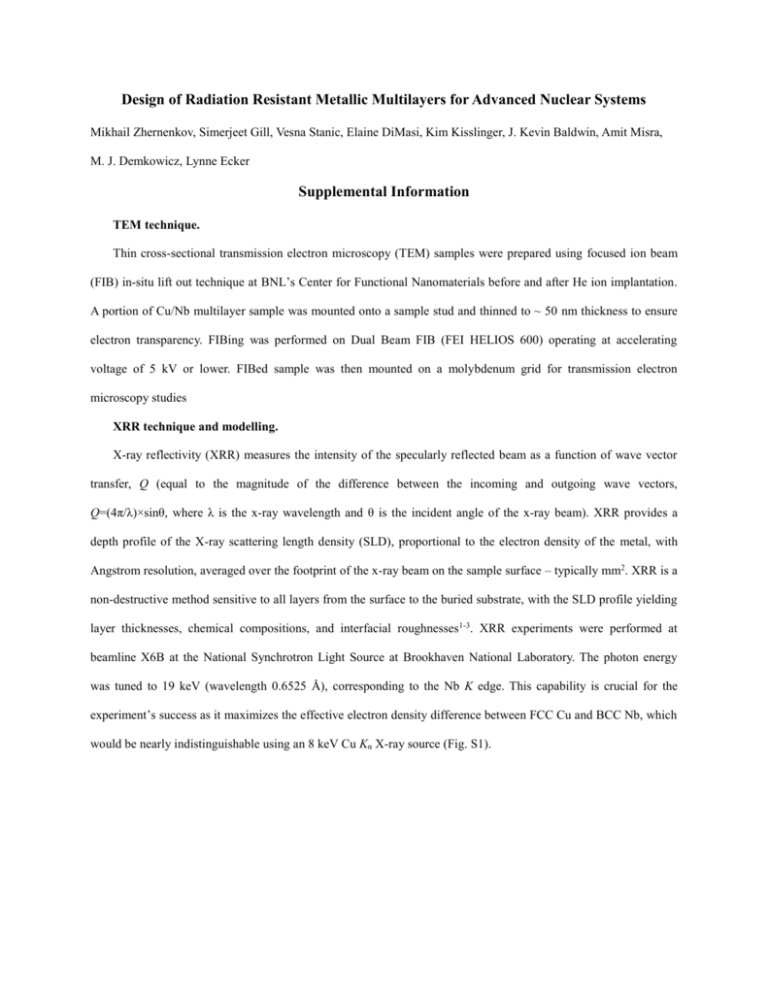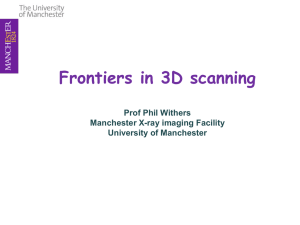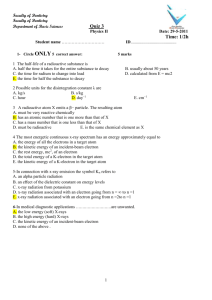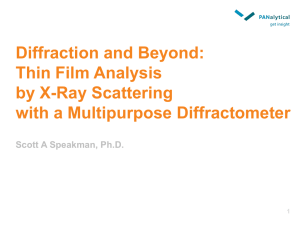Zhernenkov.Gill_APL_suppl_RESUB
advertisement

Design of Radiation Resistant Metallic Multilayers for Advanced Nuclear Systems Mikhail Zhernenkov, Simerjeet Gill, Vesna Stanic, Elaine DiMasi, Kim Kisslinger, J. Kevin Baldwin, Amit Misra, M. J. Demkowicz, Lynne Ecker Supplemental Information TEM technique. Thin cross-sectional transmission electron microscopy (TEM) samples were prepared using focused ion beam (FIB) in-situ lift out technique at BNL’s Center for Functional Nanomaterials before and after He ion implantation. A portion of Cu/Nb multilayer sample was mounted onto a sample stud and thinned to ~ 50 nm thickness to ensure electron transparency. FIBing was performed on Dual Beam FIB (FEI HELIOS 600) operating at accelerating voltage of 5 kV or lower. FIBed sample was then mounted on a molybdenum grid for transmission electron microscopy studies XRR technique and modelling. X-ray reflectivity (XRR) measures the intensity of the specularly reflected beam as a function of wave vector transfer, Q (equal to the magnitude of the difference between the incoming and outgoing wave vectors, Q=(4π/λ)×sinθ, where λ is the x-ray wavelength and θ is the incident angle of the x-ray beam). XRR provides a depth profile of the X-ray scattering length density (SLD), proportional to the electron density of the metal, with Angstrom resolution, averaged over the footprint of the x-ray beam on the sample surface – typically mm2. XRR is a non-destructive method sensitive to all layers from the surface to the buried substrate, with the SLD profile yielding layer thicknesses, chemical compositions, and interfacial roughnesses1-3. XRR experiments were performed at beamline X6B at the National Synchrotron Light Source at Brookhaven National Laboratory. The photon energy was tuned to 19 keV (wavelength 0.6525 Å), corresponding to the Nb K edge. This capability is crucial for the experiment’s success as it maximizes the effective electron density difference between FCC Cu and BCC Nb, which would be nearly indistinguishable using an 8 keV Cu Kα X-ray source (Fig. S1). Supplementary Figure 1. Effective electron density of FCC Cu and BCC Nb as function of X-ray energy. The effective electron density is proportional to the X-ray scattering length density. Contrast is optimized for E = 19 keV (Nb K edge). For the reflectivity modelling we utilized dynamic Parratt's formalism4 combined with Nevot–Croce interface roughness and genetic fitting algorithm followed by the Levenberg–Marquardt refinement, using the MOTOFIT software5. Literature SLD values for the Si substrate, Cu, and Nb layers were used for modeling of both pre- and post- He implantation data sets. He ion incorporation could not be modeled directly since its low electron density has a negligible effect on X-ray SLD values (in contrast to neutron reflectometry6). Therefore, SLD parameters were kept fixed throughout modelling and only thicknesses of each layer and interfacial/surface roughnesses were varied. Sample preparation. Cu/Nb nanoscale multilayers of equal Cu and Nb layer thickness and Cu control with thickness 250 nm were synthesized using d.c. magnetron sputtering system with a base pressure of 2.0 x 10-7 torr at room temperature on a Si (100) substrate. The deposition rate was 1.2 nm/s for Cu and 7 nm/s for Nb. The total thickness of multilayer films was kept constant at approximately 250 nm. The exact layer thicknesses for all samples, measured after deposition, are shown in Table S1. All depositions were carried out at a process pressure of 6.0 x 10-3 torr (3 millitorr), with the Nb target (99.9% purity) power being 350 watts and the Cu target (99.9% purity) power being 300 watts. The sputtering system utilizes 4 inch targets and the substrate is located 4.5 inches from the target. The system has vacuum load lock so that samples may be transferred without venting the process chamber. Stopping and Range of Ions in Matter (SRIM) The stopping and range in the matters (SRIM) program developed by Ziegler et al.7,8 is used to calculate stopping and range of Helium ions into Cu/Nb multilayers. SRIM program developed by Ziegler et al uses a quantum mechanical treatment of ion-atom collisions. The interaction between the ion and atom is Coulomb and thus there is a screened Coulomb collision including exchange and correlation interactions between the overlapping electron shells. The long range interactions in the ions create electron excitations and plasmons within the target, which are described by including a description of the target's collective electronic structure and interatomic bond structure when the calculation is setup (tables of nominal values are supplied). The effective charge including a velocity dependent charge state and long range screening due to the collective electron sea of the target describe the charge state of the ion within the target7. Table S1. Model parameters used to fit XRR data for each sample. The statistics on the layer thicknesses and roughnesses is shown where applicable. Cu Before He irradiation Real SLD, Img. SLD, Thickness, Å Roughness, Å Thickness, Å 10-6 Å-2 10-6 Å-2 Single Cu layer 2183 70 2.64 24.8 2333 Nb 2197 47 5.86 Cu Nb Total: 1325.8 1233.5 2559.3 70 47 2.64 5.86 Nb Cu Nb Cu Nb Cu Nb Cu Nb Cu Nb Cu Avg.: Total: 246.42 233.29 252.53 241.44 242.94 210.62 234.28 199.04 232.09 203.17 242.41 209.28 228.96 2747.5 47 70 47 70 47 70 47 70 47 70 47 70 0.853 2.64 5.86 2.64 5.86 2.64 5.86 2.64 5.86 2.64 5.86 2.64 Single Nb layer 23.8 2454 [Cu/Nb] bilayer 31.1 1445.9 7.1 1415.6 2861.5 [Nb/Cu]6 multilayer 36.96 249.83 24.92 239.28 34.94 266.5 47.47 257.12 52.31 269.11 12.50 233.03 15.46 260.09 9.57 213.85 7.31 238.81 7.41 199.23 7.85 242.42 5.50 208.6 21.85 239.82 2877.8 After He irradiation Real SLD, Img. SLD, 10-6 Å-2 10-6 Å-2 Roughness, Å 68 2.28 28.0 45.5 3.6 29.5 70 47 2.64 5.86 29.9 5.5 47 70 47 70 47 70 47 70 47 70 47 70 0.558 2.64 5.86 2.64 5.86 2.64 5.86 2.64 5.86 2.64 5.86 2.64 35.024 21.774 44.914 41.964 45.963 33.036 13.413 24.968 8.0477 9.8624 8.1984 5.497 24.4 Nb Cu Nb Cu Nb Cu Nb Cu Nb Cu Nb Cu Nb Cu Nb Cu Nb Cu Nb Cu Nb Cu Nb Cu Nb Cu Nb Cu Nb Cu Nb Cu Nb Cu Nb Cu Nb Cu Nb Cu Nb Cu Nb Cu Nb Cu Nb Cu Nb Cu Avg.: 52.70 70.41 66.03 74.55 58.96 75.45 56.98 74.79 63.62 79.54 65.00 80.25 62.96 76.58 60.24 78.90 66.45 80.12 59.40 74.47 61.76 74.23 57.36 75.27 61.46 73.01 63.11 73.26 60.36 74.77 59.12 66.39 57.13 62.40 61.15 72.13 60.88 76.49 58.28 75.84 59.61 73.48 61.84 70.78 61.52 74.89 62.27 68.42 61.22 73.83 67.40 47 70 47 70 47 70 47 70 47 70 47 70 47 70 47 70 47 70 47 70 47 70 47 70 47 70 47 70 47 70 47 70 47 70 47 70 47 70 47 70 47 70 47 70 47 70 47 70 47 70 5.86 2.64 5.86 2.64 5.86 2.64 5.86 2.64 5.86 2.64 5.86 2.64 5.86 2.64 5.86 2.64 5.86 2.64 5.86 2.64 5.86 2.64 5.86 2.64 5.86 2.64 5.86 2.64 5.86 2.64 5.86 2.64 5.86 2.64 5.86 2.64 5.86 2.64 5.86 2.64 5.86 2.64 5.86 2.64 5.86 2.64 5.86 2.64 5.86 2.64 [Nb/Cu]25 multilayer 26.01 49.71 43.30 73.24 32.58 66.10 40.87 75.04 44.60 61.03 29.92 76.89 45.50 60.54 32.01 75.69 38.82 63.62 40.84 79.58 37.54 66.58 33.44 77.76 30.57 58.92 35.12 79.22 32.25 59.89 32.72 80.73 34.11 66.49 26.00 81.91 21.80 59.20 17.61 73.89 8.36 65.29 7.61 74.70 19.50 56.84 10.66 73.43 13.67 63.29 10.21 67.72 12.87 66.56 11.59 72.84 11.17 59.06 13.30 76.80 11.87 60.31 12.78 64.85 18.38 57.19 18.57 63.92 12.52 58.20 18.29 73.10 12.42 57.69 10.81 81.54 10.15 59.25 10.87 73.89 9.624 61.75 10.40 70.70 7.20 63.25 7.49 69.21 5.43 62.81 5.86 73.22 5.49 62.05 4.62 65.81 7.14 62.64 10.13 73.06 20.10 67.54 47 70 47 70 47 70 47 70 47 70 47 70 47 70 47 70 47 70 47 70 47 70 47 70 47 70 47 70 47 70 47 70 47 70 47 70 47 70 47 70 47 70 47 70 47 70 47 70 47 70 5.86 2.64 5.86 2.64 5.86 2.64 5.86 2.64 5.86 2.64 5.86 2.64 5.86 2.64 5.86 2.64 5.86 2.64 5.86 2.64 5.86 2.64 5.86 2.64 5.86 2.64 5.86 2.64 5.86 2.64 5.86 2.64 5.86 2.64 5.86 2.64 5.86 2.64 5.86 2.64 5.86 2.64 5.86 2.64 5.86 2.64 5.86 2.64 5.86 2.64 32.21 40.32 38.32 40.01 35.51 37.46 32.85 41.97 33.91 42.43 34.11 39.59 31.70 46.60 31.10 46.33 36.89 36.14 31.90 22.46 14.35 12.79 14.64 13.84 8.462 4.414 10.34 10.18 12.78 11.82 15.81 12.36 14.98 19.77 23.84 19.13 13.54 13.61 12.98 12.27 12.31 12.04 7.77 8.72 6.66 6.04 5.43 4.40 6.95 10.24 21.68 Total: Avg. Nb Avg. Cu 3369.9 60.78 74.01 3377.2 61.22 73.95 Supplementary References: 1. Jens Als-Nielsen, Elements of Modern X-Ray Physics, Wiley, New York, (2001). 2. J.Daillant, A.Gibaud, X-Ray and Neutron Reflectivity: Principles and Applications. Springer, (1999). 3. M.Tolan, X-Ray Scattering from Soft-Matter Thin Films, Springer, (1999) 4. L.G. Parratt, Phys. Rev., 95, 359 (1954) 5. A. Nelson, J. Appl. Cryst., 39, 273 (2006). 6. Mikhail Zhernenkov, Michael S. Jablin, Amit Misra, Michael Nastasi, Yongqiang Wang, Michael J. Demkowicz, Jon K. Baldwin, Jarek Majewski, Appl. Phys. Lett. 98, 241913 (2011). 7. J.F. Ziegler, M.D. Ziegler, J.P. Biersack, http://www.srim.org/, July 1, 2009. 8. J.F. Ziegler, M.D. Ziegler, J.P. Biersack, http://www.srim.org/srim/srimintro.htm






